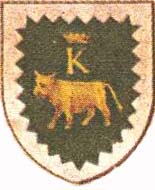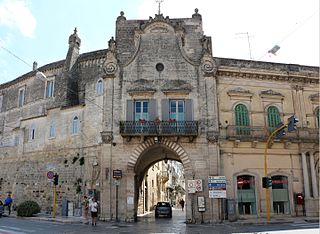Related Research Articles

Altamura is a town and comune of Apulia, in southern Italy. It is located on one of the hills of the Murge plateau in the Metropolitan City of Bari, 45 kilometres southwest of Bari, close to the border with Basilicata. As of 2017, its population amounts to 70,595 inhabitants.

The House of Bove is an ancient noble patrician family of Ravello, Maritime Republic of Amalfi that held royal appointments in the Kingdom of Naples, and presided over feudal territories. After the dissolution of noble seats of the Kingdom of Naples in 1800 they were ascribed in the Libro d'Oro of Ravello. The Bove coat of arms is prominently displayed in the Duomo of Ravello.

The Diocese of Altamura-Gravina-Acquaviva delle Fonti is a Roman Catholic diocese in Apulia, southern Italy, 40 km south-west of the coastal city of Bari. In 1986. the territorial prelature of Altamura e Acquaviva delle Fonti was united with the diocese of Gravina. The present diocese is a suffragan of the archdiocese of Bari-Bitonto. The seat of the bishop is at Altamura Cathedral, with Acquaviva Cathedral and Gravina Cathedral as co-cathedrals.

Cimino, Cimini or Cimina Whether all beares of this name are related can most likely be dismissed, the variations of the spelling and transcript will vary from source to source, and as research goes on it may change the information in this article. The origin of the name is disputed, but certainly a branch of the family has taken the name from the Cimini Hills, in Latium. The origin of the Cimini name in this context goes back to the Etruscan era. The use of Cimini as a family name can be traced through history. In a study of family names in Roman Legions, the name DeCiminus is found C. Catullius DeCiminus of Troyes was a Roman Federal priest of the Roman Cult in 210 AD, who dies in Lyon. The name Ciminius is also documented in "Repertorium nominum gentilium et cognominum latinorum" The "Journal of Archaeology" states "Ciminius" as a known gentilitium nomina in ancient Rome. The ending "nius" is a clear indicator to the names Etruscan origin (which also may have the ending "na". C. Ciminius is registered as vicomagister of the vicus Silani Salienti first half of the second century, under the reign of Claudius.

The church of Santi Severino e Sossio and the annexed monastery are located on via Bartolommeo Capasso in Naples, Italy.

The church of the Croce di Lucca is a religious edifice in central Naples, Italy, on the Via dei Tribunali.

Sebastiano Biancardi, known by the pseudonym Domenico Lalli, was an Italian poet and librettist. Amongst the many libretti he produced, largely for the opera houses of Venice, were those for Vivaldi's Ottone in villa and Alessandro Scarlatti's Tigrane. A member of the Accademia degli Arcadi, he also wrote under his arcadian name "Ortanio". Lalli was born and raised in Naples as the adopted son of Fulvio Caracciolo but fled the city after being implicated in a bank fraud. After two years wandering about Italy in the company of Emanuele d'Astorga, he settled in Venice in 1710 and worked as the "house poet" of the Grimani family's theatres for the rest of his career. In addition to his stage works, Lalli published several volumes of poetry and a collection of biographies of the kings of Naples. He died in Venice at the age of 62.

Altamura Castle was a castle located in the city of Altamura, now completely demolished. It was located over today's piazza Matteotti and a few remains of it are still visible inside the adjacent buildings, which were built partly with stones and structural elements from the castle. In a warehouse are an ogival arch and some stone coats of arms. A few other remains are found in the adjacent buildings, which were built in the 19th century.

Pulo di Altamura is a doline located on the Murge plateau. It is the largest doline in that region and it is located about 6 kilometers (3.7 mi) north-west of the city of Altamura. It shares the local toponym pulo with other large dolines of the region, i.e. Pulicchio di Gravina, Pulo di Molfetta and Pulicchio di Toritto.

Luca de Samuele Cagnazzi was an Italian archdeacon, scientist, mathematician, political economist. He also wrote a book about pedagogy and invented the tonograph.

The Altamuran Revolution was a three-month period of self-government of Italian town Altamura, right after the birth of the Parthenopean Republic which ousted the Bourbons and the Kingdom of Naples. The city of the Kingdom of Naples was then defeated and taken by the so-called Sanfedisti, led by cardinal Fabrizio Ruffo, after a battle on the city walls. After being defeated, most Altamurans managed to flee through Porta Bari, one of Altamura's main gates.

Vitangelo Bisceglia was an Italian botanist, agronomist and professor. He taught inside the University of Altamura. Because of his being a polymath, he's been described as "an encyclopedic spirit, the honor of the Muses".

Ottavio Serena was an Italian politician, judge, prefect and historian. He is known in his hometown Altamura for his works about local history, such as the Altamuran Revolution (1799). His contribution and the testimonies he collected allowed to shed light on some historical events (such as the killing of Giovanni Firrao and on legendary toponyms.

Piazza del Duomo is the main square of the city of Altamura, Italy. It is located in the center of the historic city center, as well as in the middle of the main street of the city, that is corso Federico II di Svevia. Moreover, Altamura Cathedral, the main church of the city, is located on the square. It is also known because the Tree of Liberty was planted in this square during the so-called Altamuran Revolution (1799).

Marcello Papiniano Cusani was an Italian archbishop, professor of both civil law and canon law as well as founder and rector of the University of Altamura.
Biagio Cusano was an Italian Marinist poet and professor of law. The date of his birth is currently unknown. He is best known for being Gennaro Cusano's uncle and Marcello Papiniano Cusani's grand uncle.

Porta Bari, previously called Porta de Bari, was one of the main gates of the city of Altamura, before the city walls of the city were torn down over the 19th century. Similarly to most European cities, the city walls were torn down, because the new technology and military techniques employed starting from the 19th century made them useless for defense purposes.

Porta Matera was one of the main gates of the old city of Altamura. They were part of the City Walls of Altamura, which were completely demolished during the nineteenth century since they had become useless for defence purposes. The gate itself was demolished in 1872. The monastery Monastero del Soccorso is located on the left side of the gate, while on the right some ruins of the city walls can be seen, presumably saved from destruction because of the bas-relief depicting "Pipino's leg".

The City Walls of Altamura were a military structure meant for defensive purposes and located in the city of Altamura, Italy. Its origin dates back to the Middle Ages and it was in use until the 19th century when it started to be gradually torn down. Nowadays only a few isolated parts of the walls survive. It shouldn't be confused with the Megalithic Walls of Altamura, which date back to the 5th–4th century BC and intersect in some parts with the city walls.

Antonio Bulifon (1649-1707) was a French printer working in Naples. As a publisher Bulifon was "fundamentally important for the diffusion of women's poetry" in Italy.
References
- 1 2 3 "Francesco Cassiano de Silva".
- 1 2 3 pupillo-immagini, p. 40
- ↑ "nobil milanes en Napoles ano de 1708"
- ↑ pupillo-immagini, pp. 91-92
- ↑ "Le mappe di Cassiano 'vedutista' del mistero - la Repubblica.it".
- 1 2 pupillo-immagini, p. 42